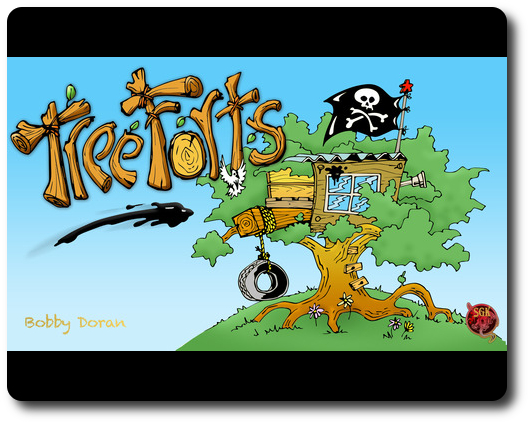
The Basics:
- For ages 8 and up
- For 2 to 5 players
- Approximately 60 minutes to complete
Geek Skills:
- Active Listening & Communication
- Counting & Math
- Logical & Critical Decision Making
- Reading
- Strategy & Tactics
- Visuospatial Skills
- Hand/Resource Management
Learning Curve:
- Child – Easy
- Adult – Easy
Theme & Narrative:
- Build the best tree fort in the neighborhood!
Endorsements:
- Gamer Geek mixed!
- Parent Geek approved!
- Child Geek approved!
Overview
Growing up, I had a tree house that the neighborhood kids help build. It was little more than a haphazard structure primarily made out of scrap wood and cardboard. It wasn’t much to look at, but to us it was as grand as the Taj Mahal. In this game, you will relive your younger years and recapture the excitement of building your very own tree fort.
Tree Forts, designed by Bobby Doran and published by Simi Game Knights via the Game Crafter, is comprised of 112 Tree Fort cards, 20 Candy discs, 15 Water cubes, 15 Mud cubes, 15 Tape cubes, 15 Rope cubes, 15 Nail cubes, and 3 Supply mats. The mats are made of thick cardstock and the cards are as durable as your standard playing card. The discs and cubes are made of wood. The illustrations in the game, also by Bobby Doran, are colorful and stylized, enhancing the game’s theme while accurately representing various items used by the players.
Finding the Perfect Tree
To set up the game, first place the 3 Supply mats in the middle of the playing area and within easy reach of all the players. The order of the Supply cards in the row is important. At the far left, place the Supply card with the 3 and 2 Candy icons. Going right, the middle Supply card should have a single Candy icon and the word “Free”. At the far right, the Supply card should have the words “Draw Pile Free” and “Discard”.
Second, look through the Tree Fort cards and remove 1 “Pallet” Tree Fort card per player. Give each player a “Pallet” Tree Fort card, which should be placed in front of them. This is the base from which they will expand and improve upon their Tree Fort. Make certain each player has enough room to build the Tree Fort of their dreams. Place any “Pallet” Tree Fort cards not used back with the rest of the cards.
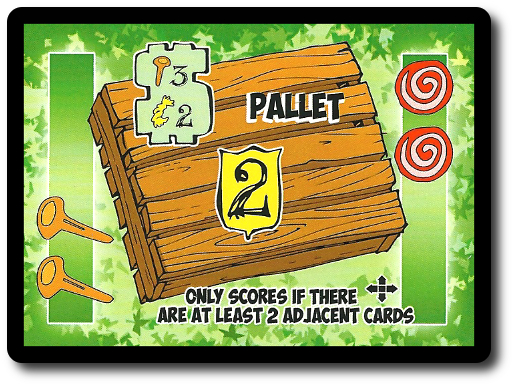
Third, shuffle the cards and place the deck face-down in the designated area noted as the “Draw Pile” found on the Supply mats. Draw 1 card at a time and fill the “Free” space, as well as the 1, 2, and 3 Candy icon spaces. These cards should be placed face-up.
Fourth, give each player 3 cards from the draw pile. Players should keep these cards hidden from their opponents until played.
Fifth, give each player 2 Candy discs. All resources owned by the player (other than cards) must be in plain sight at all times.
Sixth, place the rest of the resource cubes and the Candy discs at one end of the Supply mat in different piles. This is the general supply.
That’s it for game set up. Decide who will get first and get building!
The Anatomy of a Tree Fort
There are only 3 components in the game that need to be discussed in details. These are the Tree Fort cards and the resources. Each are summarized here.
Tree Fort Cards
The Tree Fort cards are used by the players to build onto their structures. Card placement is important and there are restrictions on where and when the cards can be used. Tree Fort cards cost resources to build, but they can also be sold for resources. Every player starts with the same Tree Fort card. From there, players will design their own, making each unique.
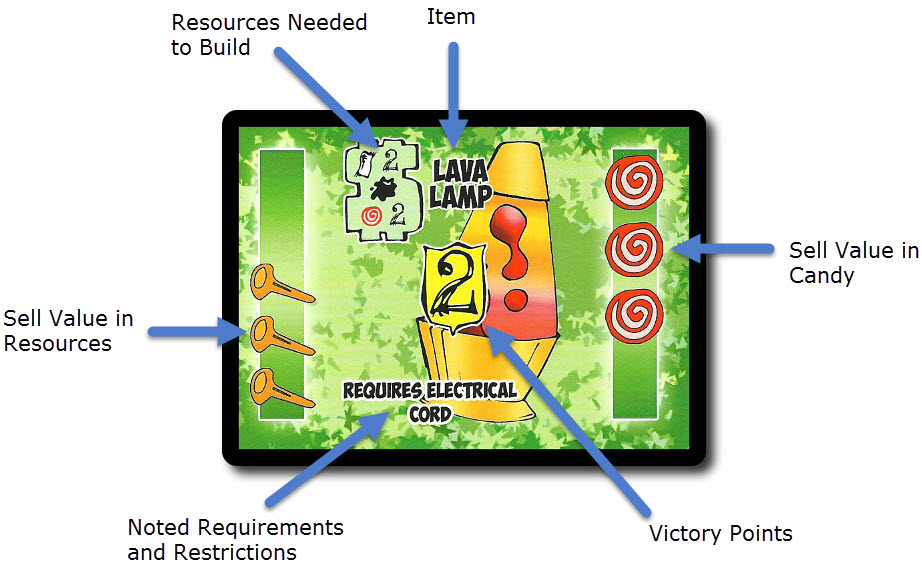
Resources and Candy
Candy is used as a form of currency in the game. Using it, new Tree Fort cards can be purchased. To build a Tree Fort card, the player must have the correct number and type of resources. These are mud (black cubes), nails (orange cubes), water (blue cubes), tape (white cubes), and rope (yellow cubes). All Candy discs and resource cubes are limited in number, meaning that once they are gone, they are gone. However, there are Tree Fort cards that will provide unlimited resources to the player who own them. There are also additional sources of candy that allow the player to keep a healthy supply of sweets to buy needed materials.
Fort to Fort Combat
Building forts is no fun if you cannot attack them. While most Tree Fort cards are used to build and reinforce, there are a small number that are specifically designed to attack opponents. Water and mud are the weapons of choice in the neighborhood.
Tree Fort cards that allow players to attack are built and have the same placement restrictions as any other Tree Fort card. However, the player can pay additional resources during their turn to use the Tree Fort card to attack. Unless the opponent has a “Tarp” Tree Fort card to cover their fort, any attack will succeed. Hit Tree Fort cards are flipped over and a mud or water resource cube is placed on it, signifying that it is now a “mess”.

Messy cards do not provide victory points, but can be easily cleaned up by discarding a Tree Fort card. This counts as 1 action.
Building Your Tree Fort
Before the game can begin, the players must agree upon a target victory point total. Values are provided based on the number of participants, but players can determine their own goal. The first player to obtain the agreed upon victory point goal will win the game. After all the players are in agreement, the first player takes their turn.
Tree Forts is played in turns. During a player’s turn, they can take up to 3 actions. The available actions are summarized here. They can be taken in any order and multiple times as long as the number of actions taken does not exceed 3 in total.
Buy or Draw a Card
The player can always draw 1 card from the Draw pile for free. While this will not cost the player anything (other than an action), it’s a blind draw, meaning the player has no idea what they will get.
The player can also purchase a face-up Tree Fort card. The Candy icons above the card indicate how many Candy discs must be spent and returned to the general supply. The Candy disc cost does not indicate the necessary resource cubes to build the card. If the Tree Fort card is in the Supply mat area noted as “Free”, the player can take the face-up card without spending any Candy discs.
The top-most card in the Discard pile can also be purchased at the cost of 1 Candy disc. However, the player is unable to do so if they have sold or discarded any Tree Fort cards during their turn.
A player may never have more than 6 Tree Fort cards in total by the time their turn ends. If the player exceeds this limit at the end of their turn, they will be forced to discard down to 6.
Sell Cards for Candy and Resources
Any card in the player’s hand can be sold for the listed resources or candy. The player announces they are selling the Tree Fort card, place it face-up on the discard pile, and then collects the resources or the candy noted on the card. Not both. A player may never have more than 9 resources cubes in total by the time their turn ends. If the player exceeds this limit at the end of their turn, they will be forced to return resources back to the general supply.
Build Your Fort
To build onto the fort, the player must first be able to pay the listed resource cost noted on the Tree Fort card. These resources are returned to the general supply. Second, the player must be able to place the Tree Fort card. Some Tree Fort cards must be built on top of a previously placed Tree Fort card, while most require the player to place the Tree Fort card adjacent to another. The Tree Fort card will indicate how it must be added (no indication means anywhere), but it’s up to the player to determine where to place it based on the placement restrictions. If the player cannot satisfy the resource cost and the placement restrictions, they cannot play that Tree Fort card.
Some cards require players to have previously built other Tree Fort cards before they can be used. For example, a player cannot add the “Boob Tube” Tree Fort card unless they already added the “Electrical Cable” Tree Fort card.
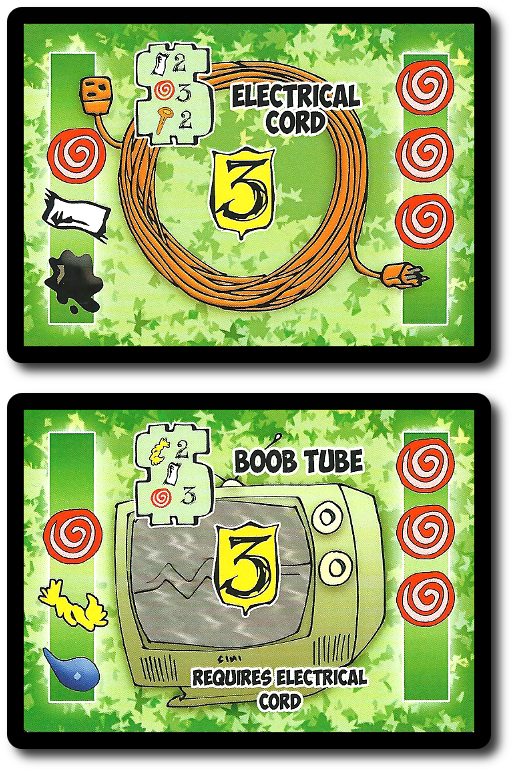
Playing cards on top of other cards, while required for some, will always make the covered card null and void. No victory points will be provided and any future Tree Fort cards that require that particular card before it can be added cannot use it. However, any cards that have used it in the past for their placement do not have to be removed.
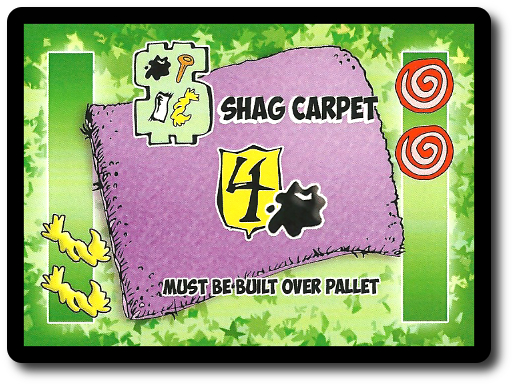
Activate Tree Fort Cards
Build Tree Fort cards can be activated for the effect. Only those Tree Fort cards connected to the player’s tree fort can be used. The necessary resources are spent and the card is immediately resolved.
Trade Resources
Trade a set of 3 resource cubes of any color for 1 resource cube of any type. If the acquired resource from the trade is used on the player’s turn as part of the build action, the trade action is considered “free”. That is to say, the player is given back an action to use during their turn.
End of Turn
After taking their 3 actions, the player’s turn is over. They must discard down to 6 Tree Fort cards and 9 resource cubes at this time before the next player takes their turn.
Then all players take a quick moment to add up their victory points earned so far. If none of the players’ total equals the victory point goal, the game continues.
Before the next player takes their turn, any cards on the Supply card move towards the Draw pile, reducing their cost in the process. Then new cards are drawn to fill in any empty spaces.
It’s now the next player’s turn.
Winning the Game
The first player to earn the previously determined victory point goal triggers the endgame. Everyone has one last turn to make as many points as possible. When done, all players count their victory points. Only those victory points that are visible (not covered up by other cards) count. One victory point is also given for every group of 5 resources and unused candy. The player with the most victory points wins the game.
On the off-chance that all the Tree Fort cards are drawn before a player triggers the endgame, everyone has one last turn to make as many points as possible. Then victory points are determined as normal.
Note that Tree Fort cards that have been attacked by opponents and are currently considered a “mess” are not counted.
House Rule
The game comes with predefined victory point goals based on the number of players. Depending on the number of players in the game, a single session could last as short as 30 minutes or over an hour. The victory point goal is just a number value and can be adjusted as needed. For shorter games, we reduced the goal value and for longer games we increased it. You can also adjust the goal value during the game if it looks like it will last longer than desired.
To learn more about Tree Forts, visit the game’s web page.
Final Word
The Child Geeks enjoyed the game, but found it frustrating at times to be unable to build what they envisioned. According to one Child Geek, “I want to build my tree fort a very specific way and I can’t see how to do it. I don’t like that I have to add things on when I don’t need them.” I’m going to chalk this one up to the Child Geek being part of the Minecraft Generation. While the game does allow you to modify and change the tree fort, players are limited by what they have in hand. Another Child Geek said, “The best part of this game is the rush you feel when you suddenly see exactly how you are going to win.” Which is to say, players will begin to see a path they can take to victory. Through clever card plays and smart resource management, a player can move ahead faster than their opponents. Until they attack them, that is. As one Child Geek put it, “When push comes to shove, I’m hitting you with my water balloons.” When the games were over, the Child Geeks voted to approve Tree Forts.
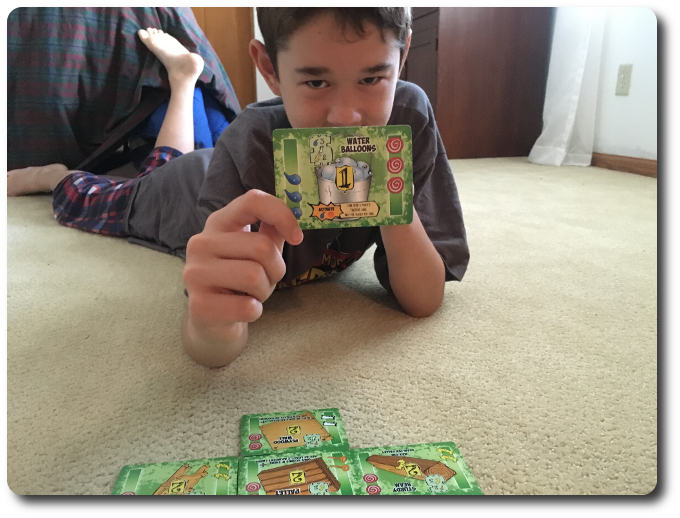
Oh…crap…
The Parent Geeks also enjoyed the game. According to one Parent Geek, “It’s one part race, one part puzzle, and one part good old-fashioned combat. I think it all adds up to a lot of fun.” Usually I reserve the corny lines to my final thoughts, but I’m going to give this one to the Parent Geek, as I believe they are 100% correct. Another Parent Geek said, “I like games like this. Everyone starts out on the same footing and from there, how well you do is based on your own actions.” Well, up until players attack you, that is. During one game playing session, a father was attacked by his children and wife continually. Makes you wonder. When water balloons were put away, the Parent Geeks approved Tree Forts for their family and peers.
The Gamer Geeks liked what the game was about, but were not overly impressed. According to one Gamer Geek, “It’s OK, but nothing special. I don’t like some of these cards and the game play makes sense, but only after someone explains it to you.” Another Gamer Geek said, “This game was obviously designed by someone who knows it inside and out because they seemed to have missed the boat regarding the game components. I think each needs to be marked with some sort of icon that says where it can be built.” But these are trivial issues, aren’t they? Not according to some of the Gamer Geeks. Although, not all of the elitists found fault with the game. As one Gamer Geek put it, “Small design flaws aside, I think the game is solid. It makes you think, is fun, and can result in an epic race to the end.” The Gamer Geeks couldn’t decide if the game was a good one, a good with some design issues, or a game that was just not ready for mass play. The end result was a mixed approval by the Gamer Geeks.
Tree Forts is a great introduction to games where resource management and building skills are necessary components to winning the game. It doesn’t hurt that the game also has light player interaction that allows opponents to mess with each other, but never to a point where anything is destroyed. Tree Forts is, in many respects, a lot like the games we played as kids. We had big ideas, limited resources, and a healthy rivalry with the other kids in the neighborhood. The kind where your friends today will be your enemies tomorrow, but you’re excited to go to their birthday part on Saturday.
The game is simple without being mindless. What a player should and should not do is most of the time obvious. I say “most of the time”, because there are often multiple paths that the player can take. It’s impossible to say if one path is better than another until the gift of hindsight is bestowed upon the player later in the game. After playing and observing many games, I have yet to see any player build themselves into a corner, but I have seen many players lament about “what could have been” after the games were over.
The attacking aspect in the game is not necessary, but I cannot imagine playing the game without it. Some of our players didn’t care for it, but that’s only because they wanted to be left alone so as to build the tree fort of their dreams. Unfortunately for them, that’s not what this game is about. It encourages you to chase your dreams, but also to throw mud in the eyes of others. After all, there can be ONLY ONE tree fort in the neighborhood that is the “best”.
The only aspect of the game that I found disappointing was the rule book. It’s not a mess, necessarily, but it’s incomplete. Incomplete and a bit disorganized. Which is ironic because the game is neat and orderly. However, I have played many games where the game play was outstanding and the rule book was junk, or vice versa. The good news here is that a player can learn the game pretty easily, but not quickly. A bit of hunting in the rule book will be necessary and questions asked during the game are not easily answered by simply scanning the rules.
Overall, this was a fun game. I enjoyed the challenge of building my tree fort, sending the occasional barrage of attacks to nearby opponents, and lamenting over my lack of resources. The game gives you more than enough to think about without giving you a headache, provides enough room to make things difficult without putting you in a corner, and encourages you to be as aggressive as you like, but doing so won’t earn you any points. It’s a great mix of light strategic and tactical game play with a serious enough resource management focus to accountants sit up and take notice. If you are looking for a game to play with family and friends that is all about building an epic tree fort worthy of ZEUS, then do play Tree Forts.
This game was given to Father Geek as a review copy. Father Geek was not paid, bribed, wined, dined, or threatened in vain hopes of influencing this review. Such is the statuesque and legendary integrity of Father Geek.



